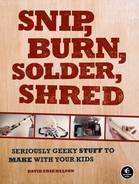Conventional wisdom among luthiers (craftspeople who build and repair stringed instruments) is that 75 percent of an electric guitar’s tone is defined by the pickups and strings, 15 percent by the quality of the neck, and 10 percent by “miscellaneous” factors (which include the entire body of the guitar, as well as hardware, bridge design and composition, electronics, etc.). In contrast to an acoustic guitar—whose body is almost wholly responsible for the instrument’s timbre and volume—the shape, material, quality, and construction of an electric guitar’s body has little bearing on its voice. To illustrate this point, the famous Roberto-Venn School of Luthiery in Phoenix, Arizona, keeps a vintage Fender guitar neck and pickups bolted to an old tool box; seasoned luthiers and pickers report that it sounds “basically like a Fender.” The single-string electric guitar we’re going to build in this project has a white maple neck (tough enough to make clean contact with the strings when you fret a note and dense enough to resonate nicely) and a hand-wound single-coil pickup, and it sounds reasonably like a ’50s roadhouse guitar. Not too shabby for $10 in parts.
In the pre-electric era these single-string guitars were called diddley bows. They were likely brought to the United States by slaves from West Africa and are a cornerstone of blues guitar, especially Delta-style slide guitar. As folk instruments, diddley bows are traditionally made from just about any wood and wire that comes to hand. Delta bluesman Lonnie Pitchford used to make an ad hoc diddley bow by nailing a piece of wire to his porch (there’s even a diddley bow built into his tombstone in Holmes County, Mississippi). Although you could use any old scrap of wood for the neck, hardwood (like maple) will be much easier to play. A steel guitar string, backed by the pressure of your fingers, will easily cut grooves into soft wood like pine, making it hard to get good contact between the string and board and thus produce a clean note. Similarly, a wound guitar string is much easier on the fingers than a piece of baling wire.
an electric drill with 1/2″ and 3/16″ bits
100-grit sandpaper
a wood saw
an electric sander or a sanding block (Maple is hard; if you have access to an electric sander, you’ll want it for this project. If you don’t have either of these, you can improvise a sanding block by wrapping your sandpaper around a soap bar–sized scrap of 2″×4″.)
a standard soldering kit (See the appendix.)
(optional) a chromatic tuner

